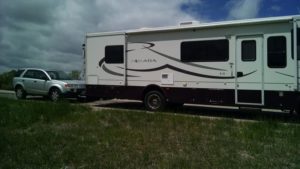I was reading through other posts and someone had the exact same symptoms I have:
This person had swapped an engine tranny from auto to manual. After installing the new engine, the car would start, idle great for about three seconds, then all the sudden start running rough for about three seconds, then abruptly quit. (I’ll post a video and link as soon as this forum allows me to)
In reading the post, the person mentioned the electrical plug for the Throttle body and the Fuel injection rail are identical, and can easily be plugged into the wrong place.
One of the problems with inheriting a five your old project, I have no idea what the previous owner has done, or screwed up. A couple weeks ago I had unplugged everything and was cleaning up wire runs, soldering connections, and tracing a couple data lines. At that time, I wasn’t aware of the connectors that could be plugged into the wrong places, or I would have checked for this. (URGH)
However, before I reconnected them last week, I did verify the correct plugs went to the correct places.
Now the bad news. My current symptoms are exactly the same as the previous poster, so I’m going to assume the plugs were connected to the wrong items and toasted the ECM and the MAP sensor.
I found an ECM out of a manual transmission (eBay) and also ordered a new MAP sensor from Rock Auto.
When this stuff comes in, hopefully this will cure this problem.
IDENTIFY THE CORRECT PLUG
Below are the three photos
1) Shows the correct plug that is plugged into the Throttle body, There are 8 wires in the connector, but notice you can easily see the four wires on one side of the connector thats facing you;
Pin A – GREEN
Pin B – BLACK/WHITE
Pin C – GRAY
Pin D – PURPLE
2) Shows the diagram of the Throttle Body plug
3) Shows the Fuel Injector plug
UPDATE
FUEL SYSTEM
I drained the 5 year old gasoline and dropped the tank. I cleaned it out, it looked reasonably clean inside. I replaced the fuel pump while I had it down. Also a new fuel filter.
The fuel line and charcoal purge lines were rusted very bad, so I installed new lines
I installed high pressure hose for the fuel line and OEM nylon tube for the vent line. Used ample black wire ties to hold it all to the frame near the original runs.
WIRING
Verified data lines from the ECM to the BCM. re-soldered bad connections for clutch and alternator wiring.
NEW PLUGS
I installed new plugs, The old ones looked new, but sooty.
TIMING CHAIN INSPECTION
I popped the valve cover and looked at the timing chain and guides, I couldn’t see any wear or anything that looked out of the ordinary.
NEW SYMPTOMS
The car now starts. It runs smoothly for about 5 seconds, then suddenly start running rough for about 5 seconds, then abruptly shuts off. I’ll need to hook up a fuel pressure gauge, but an initial test (pressing the test valve) shows it has pressure.
I also notice the A/C fan is running.
I’ m suspecting I have the wrong ECM module in it I bet I have and ECM for an auto tranny, not a manual tranny.. Its throwing four codes,
502 – Speed Sensor
701 – Transmission control
1514 – Airflow / TB miscalculation
U2106 – Transmission datalink.
In a manual transmission, there is no Automatic Module, so whyis it throwing the code U2106?
JUNK YARD VISIT – I made a trip to the junk yard , I did find a 2005 Vue with a Manual tranny, but the ECM was already removed. (darn) I took pictures of the BCM
Anyway, Since I don’t have any information on the original donor vehicle, I took a shot in the dark and ordered an ECM off of E-bay. The seller said it came out of a manual tranny Saturn.
Both lines were similar in how they were constructed. The lines were steel but the last 12 inches was plastic with the connector installed on the plastic tube. On the Engine side of the main fuel line, a flexible hose was crimped onto the steel line.
I cut the plastic tubes off of the steel lines and I cut the flexible hose off on the mail fuel line.
MAIN FUEL LINE
I cut the flexible hose off the steel tube in the engine compartment, leaving a couple inches of the steel tube on the flexible hose. I then cleaned the small tube and used a flare to put a very small lip on the end of the steel tube to help capture the new hose.
The other end of the main line was a 12 inch long plastic with the connector on the end. I carefully cut the plastic tubing away from the connector and can now slide the connector over the new hose.
I bought 10 ft of fuel line hose (blue color), Use high quality “Fuel Injection” clamps to clamp the hose on both ends. I used two clamps on the engine side where the hose slid over the steel tub. One clamp on the back of the hose is OK as the connector has barbs on it.
VENT FUEL LINE
The vent fuel line is similar to the main line, but it had 12 inch plastic tube with plastic connectors on both ends. I carefully cut the tube off of the plastic connectors.
A visit to the auto parts store, They had the plastic tubing that fit over the connectors (10mm OD, 9mm ID). We installed one of the connectors and a crimp clamp on the tube while at the store. Although the connectors are barbed, I decided to put one of the crimp connector clamps on each end to help seal / hold the tubing connectors off of the tubes.
I’ll install the new fuel lines this weekend.
Mar 6, 2016
Remove fuel tank – The fuel pump was intermittently blowing the fuse. so I ordered a new fuel pump. I siphoned as much gas out as I could, (about ten gallons)
Verify ECM – BCM communications – The CAN Data lines are different on a Automatic than they are a manual, so I used an ohmmeter to verify the data lines went correctly.
(ECM) J1-10 to (BCM)
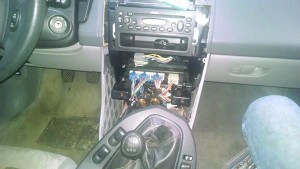
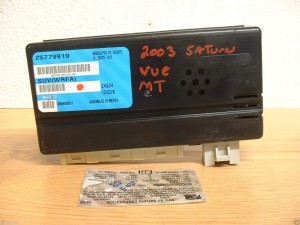
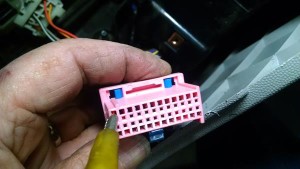
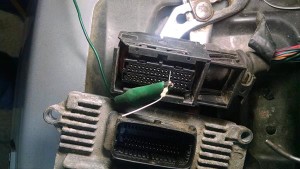
Feb 20, 2016
I just bought a 2003 Vue project that had sat for 5 years. Car is in excellent shape. the previous owner could not get it to start and run. He said it would start run for a couple seconds, then quit.
It appears as if they did a complete engine/tranny swap (5 years ago), Auto to Manual. everything looks mechanically complete, but I don’t have any info on exactly what was done.
I believe they swapped the engine compartment electrical harness but I’m not sure. It does have the manual tranny ECM. The car would try and start, but would quit. I did the security relearn procedure (30 minutes) and it then started, but ran very bad, I suspect bad gas thats been sitting for 5 years. I don’t believe its the timing chain, as the car has good compression.
I’m draining and putting in fresh gas and will try to run it again with new fuel filter, oil change, and fresh plugs.
It did have ECM codes set, I’ll clear these after I get it running again and see what codes get set.
This forum has been extreamly helpful so far, just reading through all the threads on the engine/tranny swap and other topics.
I currently have one question that I couldn’t find an answer to. In my reading, I ran across where others had performed the auto/manual swap, and they used the manual wire harness.
What is the difference between the auto and manual harnesses?
I also seen where someone said they also needed the Instrument panel harness. My question, Why. what would be the difference between the instrument panel harnesses between the Auto and Manual trannys.
Again, a BIG THANKS for this forum.

